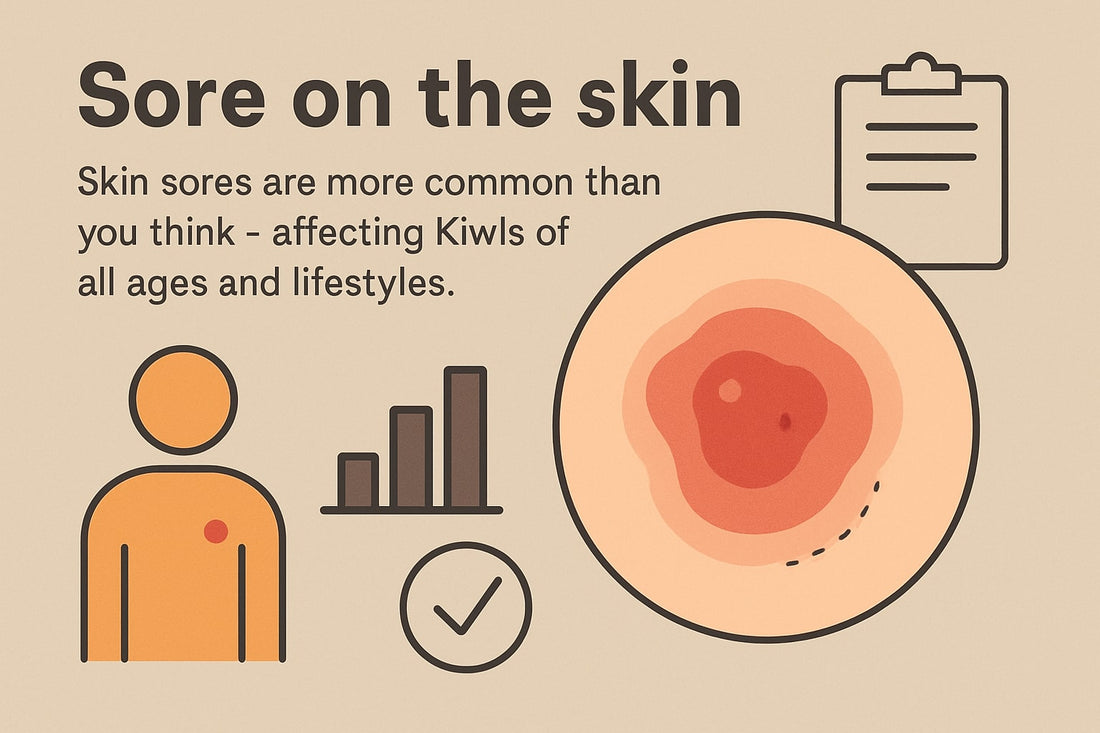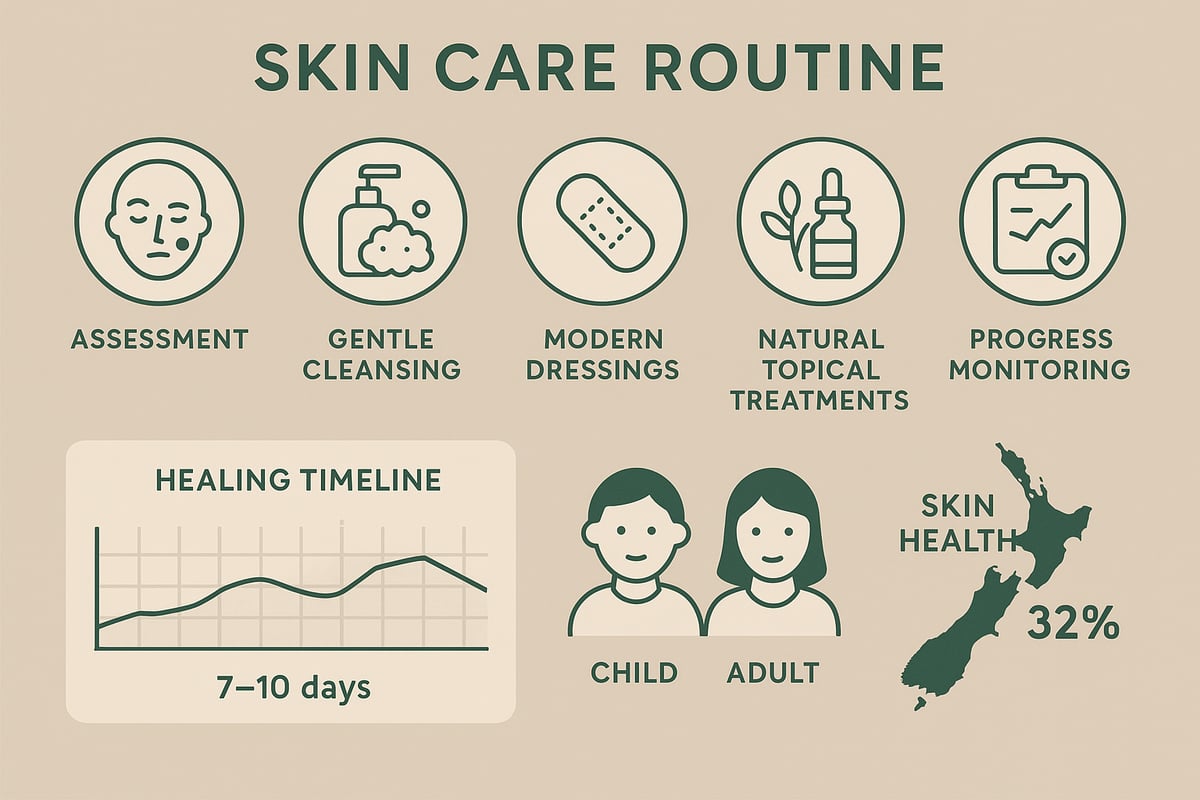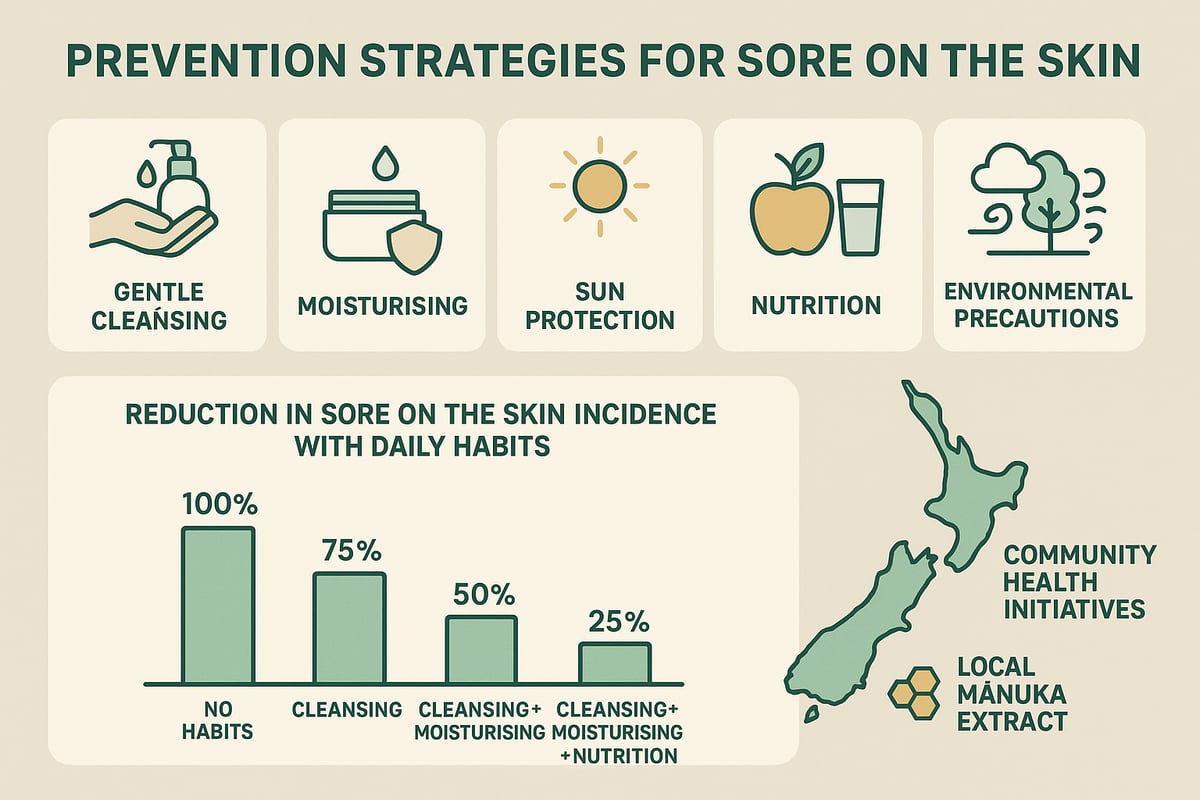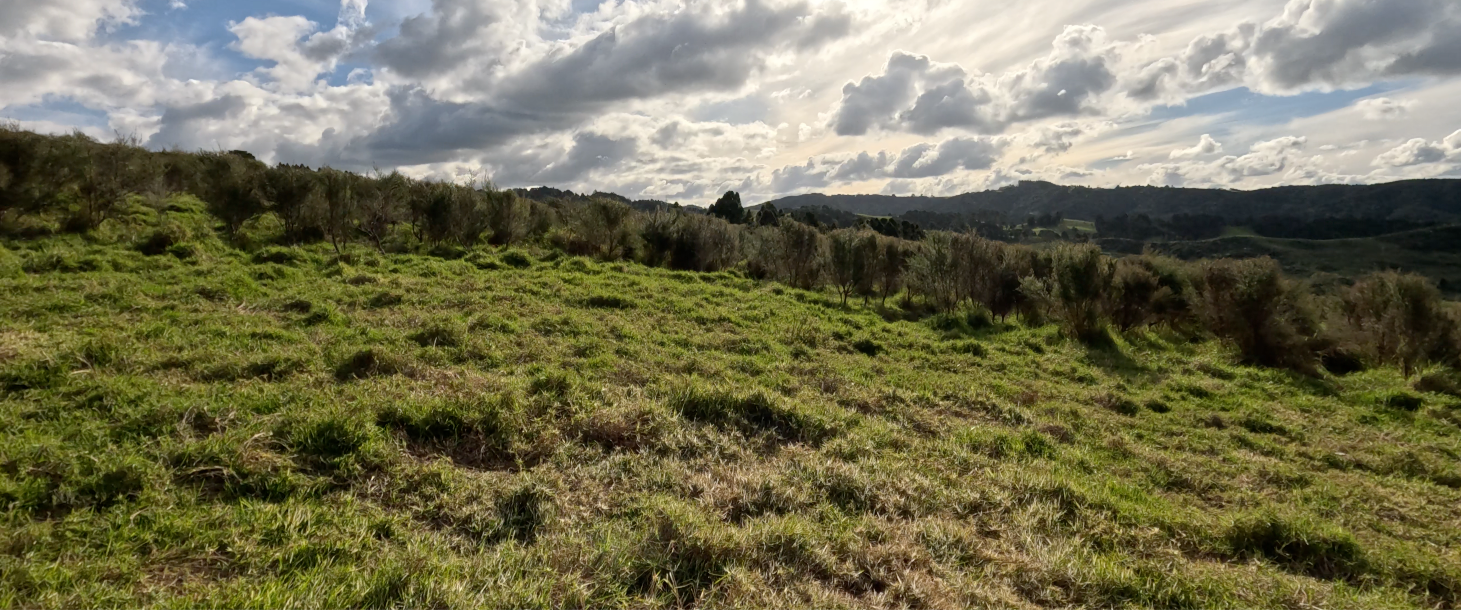
Sore on the Skin Guide: Expert Insights for 2025
Did you know a sore on the skin is one of the top reasons Kiwis visit their GP each year? These issues can affect anyone, no matter your age or background.
This 2025 guide delivers the latest expert advice for recognising, treating, and preventing skin sores. Discover the science behind different types, explore breakthrough options like New Zealand’s own Mānuka extract, and unlock everyday habits for healthier skin.
Ready to take control? Start your journey to stronger, clearer skin with tips trusted by local experts.
Understanding Skin Sores: Types and Causes
Skin health is something many of us take for granted until a sore on the skin appears. But what exactly is a sore on the skin? It covers a range of issues including ulcers, blisters, and lesions. In New Zealand, skin infections are among the top 10 reasons for visiting a GP, affecting families and individuals alike. According to the Prevalence of skin diseases, skin conditions are widespread across age groups, impacting both physical comfort and emotional wellbeing. The presence of a sore on the skin can lead to discomfort, embarrassment, and sometimes even social withdrawal, especially in children and teens.

Defining Skin Sores and Their Impact
A sore on the skin can manifest in many forms, from a simple blister after a long walk to a painful ulcer that lingers for weeks. These issues are not just minor irritations. In fact, skin sores are a leading cause of discomfort and healthcare visits in New Zealand. The emotional toll can be significant, as visible sores on the skin may affect self-esteem and daily life. Children, in particular, might feel isolated at school or during activities. Adults managing chronic conditions often face frustration and worry about healing times or complications. Understanding the true impact of a sore on the skin helps us approach treatment with empathy and urgency.
Common Types of Skin Sores
There are several types of sore on the skin, each with unique features. Pressure sores, also called bedsores, occur from prolonged pressure on one area. Cold sores, caused by the herpes simplex virus, appear as fluid-filled blisters around the mouth. Impetigo is a contagious bacterial infection, often seen in children, that creates honey-coloured crusts. Eczema-related sores can develop from scratching itchy patches. Diabetic ulcers tend to affect the feet and can be slow to heal. Each sore on the skin has its own size, shape, colour, and texture, making identification important for proper care.
| Type | Main Cause | Typical Appearance |
|---|---|---|
| Pressure sore | Pressure | Red, open, or blistered area |
| Cold sore | Viral (HSV) | Clustered blisters, often lips |
| Impetigo | Bacterial | Golden crusted patches |
| Eczema sore | Inflammation | Red, cracked, weepy patches |
| Diabetic ulcer | Poor circulation | Deep, slow-healing wound |
Root Causes and Risk Factors
The root cause of a sore on the skin can be bacterial, viral, or fungal in nature. Staphylococcus aureus, for example, is a common culprit in skin infections. Chronic skin conditions like eczema, psoriasis, or dermatitis increase vulnerability to sores. Lifestyle factors also play a role. Poor hygiene, inadequate nutrition, and underlying health issues such as diabetes make it easier for a sore on the skin to develop and linger. Environmental triggers like humidity, allergens, and irritants can further aggravate sensitive skin. Some people are genetically predisposed or have immune systems that struggle to heal wounds quickly.
- Bacterial infections (e.g., impetigo, staph)
- Viral infections (e.g., herpes simplex)
- Fungal infections (e.g., ringworm)
- Chronic conditions (eczema, psoriasis)
- Poor hygiene or nutrition
- Environmental irritants or allergens
- Genetic and immune factors
When to Seek Medical Advice
A sore on the skin is usually minor, but certain warning signs should prompt urgent medical attention. If you notice spreading redness, increasing pain, swelling, pus, or fever, it could signal a severe infection. Sores that do not heal within one to two weeks, especially in people with diabetes or weakened immune systems, need professional assessment. The NZ Ministry of Health recommends seeing a healthcare provider quickly if there are signs of cellulitis, rapid spreading, or if the sore on the skin is accompanied by systemic symptoms like chills or confusion. Early intervention is key to preventing complications and promoting healing.
Step-by-Step Guide: Caring for Sore Skin in 2025
Caring for a sore on the skin can feel overwhelming, but a clear, step-by-step approach makes all the difference. Whether you are managing a minor blister or a stubborn eczema patch, following these proven steps helps speed healing while reducing discomfort. Let’s break down best-practice care for 2025.

Step 1: Assessing the Sore
Start by examining the sore on the skin in a well-lit space. Look for redness, swelling, pus, or pain, which could indicate infection. Use a clean cotton swab or tissue—never your bare fingers—to gently inspect the area.
Take a clear photo and note any changes in size, colour, or appearance over time. This record will help you and your health professional track progress, especially if the sore on the skin doesn’t improve quickly.
- Look for signs of infection or spreading
- Record changes with photos or notes
- Avoid picking or scratching the sore
Step 2: Gentle Cleansing and Hygiene
Proper hygiene is essential when dealing with a sore on the skin. Cleanse the area twice daily using lukewarm water and a fragrance-free, pH-balanced cleanser. Pat gently—never rub—so you avoid further irritation.
Always wash your hands before and after touching the sore on the skin. This helps prevent bacteria from spreading and reduces the risk of new infections.
- Use soft cloths and gentle cleansers
- Avoid alcohol-based or harsh soaps
- Change towels daily to minimise contamination
Step 3: Protective Dressings and Bandages
Covering a sore on the skin protects it from dirt, friction, and bacteria. Modern dressings—like hydrocolloid, silicone, or antimicrobial pads—promote healing by keeping the wound moist and protected.
Change dressings as directed, usually once or twice daily, or if they become wet or dirty. Always use sterile materials and follow package instructions to prevent further irritation.
- Choose breathable, non-stick dressings
- Secure lightly to avoid pressure
- Replace if soiled or loose
Step 4: Topical Treatments and Moisturisers
After cleansing, apply a suitable ointment to the sore on the skin. Medicated creams may be prescribed for infection, but natural options like full-spectrum Mānuka extract can offer soothing antibacterial support for sensitive skin.
Hydration is key—use a fragrance-free moisturiser to help repair the skin barrier and reduce dryness around the sore.
- Select products suitable for your skin type
- Avoid steroid creams unless prescribed
- Consider Mānuka-based products for gentle care
Step 5: Monitoring and Escalating Care
Track the healing journey of your sore on the skin with daily photos or a journal. Most minor sores heal within 7–10 days, but if you notice increased pain, spreading redness, or fever, seek medical advice promptly.
Early intervention is vital if the sore on the skin shows no improvement, especially for people with diabetes, weakened immune systems, or young children.
- Monitor for warning signs of complications
- Consult your GP for non-healing sores
- Keep wounds clean and check dressings daily
Real-World Examples
Managing eczema-related sore on the skin in children requires extra patience and consistency. In a recent eczema trial week-by-week results, families found that gentle cleansing, protective dressings, and regular use of natural topical treatments like Mānuka extract led to visible improvement within days.
With the right routine, most minor sores resolve quickly, restoring comfort and confidence for all ages.
Innovations in Skin Sore Treatments: 2025 Expert Insights
Innovations in caring for a sore on the skin have accelerated in recent years. In 2025, both medical science and natural solutions offer new hope, especially for Kiwis seeking gentle yet effective care. Let’s explore what’s new, what works, and how New Zealand research is shaping the future of skin health.
Advances in Medical Therapies
Medical treatments for sore on the skin have evolved rapidly. Topical antibiotics and antivirals remain first-line for infected sores, but now we see new prescription creams and oral medications designed to target resistant bacteria and viruses.
For chronic skin conditions that cause recurring sores, biologics and immunomodulators are increasingly used. These therapies help control inflammation and reduce the risk of flare-ups. Doctors in New Zealand are also adopting advanced wound dressings that speed up healing and reduce pain.
Breakthrough Natural Solutions
Many Kiwis prefer natural choices for sore on the skin, especially when treating children or sensitive skin. Recent years have seen a surge in non-steroidal, plant-based remedies.
Mānuka honey, aloe vera, and advanced botanical extracts are leading the way. These natural solutions are backed by research showing their ability to reduce redness, soothe irritation, and help the skin repair itself. With fewer side effects, they’re a valuable option for everyday care.
Why Mānuka Extracts Are Transforming Skin Sore Care
Mānuka extracts from New Zealand are changing how we treat sore on the skin. The unique antibacterial and anti-inflammatory properties of Mānuka help fight infection and calm irritated skin, making them suitable for all ages.

Full-spectrum extracts, like those from Waipu Extracts, use advanced methods to preserve the active compounds. This means you get maximum benefit with every application. If you want to learn more about the science behind these natural remedies, check out Why Mānuka extract works for skin.
Compared to traditional ointments, Mānuka extract is gentle, safe for sensitive skin, and suitable for kids. Many users in NZ report faster healing and less discomfort.
Integrative Approaches
For the best results, many New Zealanders are combining medical and natural therapies to manage sore on the skin. Doctors may recommend using prescription treatments alongside Mānuka-based products for a balanced approach.
Local research and clinical trials continue to explore how integrating these therapies can improve healing. Whether you’re managing eczema, acne, or recurring sores, this combined approach offers a path to healthier, resilient skin.
Preventing Skin Sores: Everyday Habits and Proactive Strategies
Taking charge of your skin’s health is the most effective way to avoid a sore on the skin. Prevention is not just about what you put on your body, but also how you care for it daily, from your morning routine to your bedtime rituals.

Daily Skin Care Routines
A consistent daily routine is your first defence against a sore on the skin. Start with a gentle, fragrance-free cleanser to avoid stripping your skin’s natural barrier. Moisturise right after washing to lock in hydration. Always apply sunscreen, even on cloudy days, as UV damage can weaken your skin and make it more prone to sores.
For sensitive or high-risk areas, choose products designed for your unique needs. For more tips on caring for different skin areas, check out the Understanding skin areas and care guide.
Nutrition and Lifestyle
What you eat and drink matters just as much as your skincare products. A diet rich in vitamins A, C, E, and zinc helps your skin repair and resist infection. Hydration keeps your skin supple and less likely to develop a sore on the skin.
Aim for plenty of water, fresh fruits, and vegetables. If you have a busy lifestyle, consider meal prepping nutrient-rich snacks to support your skin health on the go.
Managing Chronic Skin Conditions
If you have eczema, psoriasis, or acne, proactive management is key. Early intervention with soothing, non-steroidal treatments, like Mānuka extract, can help prevent minor irritations from becoming a sore on the skin.
Keep track of flare-ups in a journal, and don’t hesitate to adjust your routine with your healthcare provider’s advice. Staying ahead of symptoms is one of the most powerful prevention tools.
Environmental and Occupational Precautions
Work or play can expose your skin to irritants and potential injury. Wear protective clothing and use barrier creams if you frequently handle chemicals or allergens. This simple step can make a big difference in preventing a sore on the skin.
If you notice redness or irritation after exposure, cleanse the area gently and apply a calming ointment, such as those containing New Zealand Mānuka, which is known for its natural antibacterial properties.
Community Health Initiatives
New Zealand’s public health campaigns have made a real difference in reducing sore on the skin rates. Education on hygiene, prompt treatment, and infection control has led to fewer GP visits for skin infections. For recent stats on skin infection rates in Auckland, see the Epidemiology of skin infections in Auckland.
Getting involved in community programmes or sharing resources with your whānau can help everyone stay healthier. Preventing sores is a team effort, and the benefits ripple out to all of New Zealand.
When Skin Sores Signal Something More: Red Flags and Complications
Spotting a sore on the skin can be unsettling, especially when it lingers or worsens. While many heal quickly, some sores may hint at deeper health issues. Recognising the difference is vital for prompt, effective care. Let’s break down the warning signs, complications, and steps to take in New Zealand.
Warning Signs of Serious Underlying Conditions
Not every sore on the skin is simple. If a sore persists for weeks, grows, or fails to heal, it might signal something more serious. Red flags include sores that bleed easily, change appearance, or develop alongside symptoms like fever or unexplained weight loss.
Sometimes, a sore on the skin points to underlying health issues such as diabetes, cancer, or autoimmune disorders. Watch for rapid spreading, severe pain, or a sore that keeps returning in the same spot. These are signs it’s time to consult a healthcare professional.
Complications to Watch For
A sore on the skin can sometimes lead to serious complications if left untreated. Conditions like cellulitis, sepsis, and chronic wounds can develop, raising the risk of hospitalisation. In New Zealand, severe skin infections, especially those caused by Staphylococcus aureus, are a common reason for hospital admissions. For more on this, see the Staphylococcus aureus infections in New Zealand report.
Here’s a quick summary of complications:
| Complication | Key Symptom | Risk Level |
|---|---|---|
| Cellulitis | Spreading redness | High |
| Sepsis | Fever, confusion | Critical |
| Chronic wounds | Non-healing sores | Moderate-High |
| Scarring | Skin changes | Moderate |
Navigating the Healthcare System
If you notice warning signs or complications from a sore on the skin, act quickly. In New Zealand, start with your GP, who can refer you to a dermatologist if needed. For urgent cases, local hospitals offer rapid assessment and treatment.
Knowing when to seek help is important. The Healthcare-associated infections in New Zealand resource provides insights into hospital care pathways and infection management. Keep records of your symptoms, photos of the sore, and any changes to share with your provider.
Empowering Patients
Taking charge of your skin health starts with knowledge. If you or a loved one has a persistent sore on the skin, don’t ignore it. Track healing progress, ask questions, and seek a second opinion if needed.
Support groups and online resources are available throughout New Zealand for those managing chronic wounds. Remember, advocating for yourself ensures timely care and better outcomes. Your vigilance can make a real difference in early detection and recovery.
After learning how common and frustrating skin sores can be—and seeing how much the right care can change things—it’s clear that natural, science-backed solutions are worth considering. If you’re looking to take the next step in your skin healing journey, you might want to explore the benefits of full spectrum Mānuka extract. With its proven antibacterial and soothing properties, it’s helped many Kiwis manage everything from eczema flare ups to persistent sores. You deserve skin that feels comfortable and confident—why not give nature’s best a try?
Get Your Mānuka Extract Today

